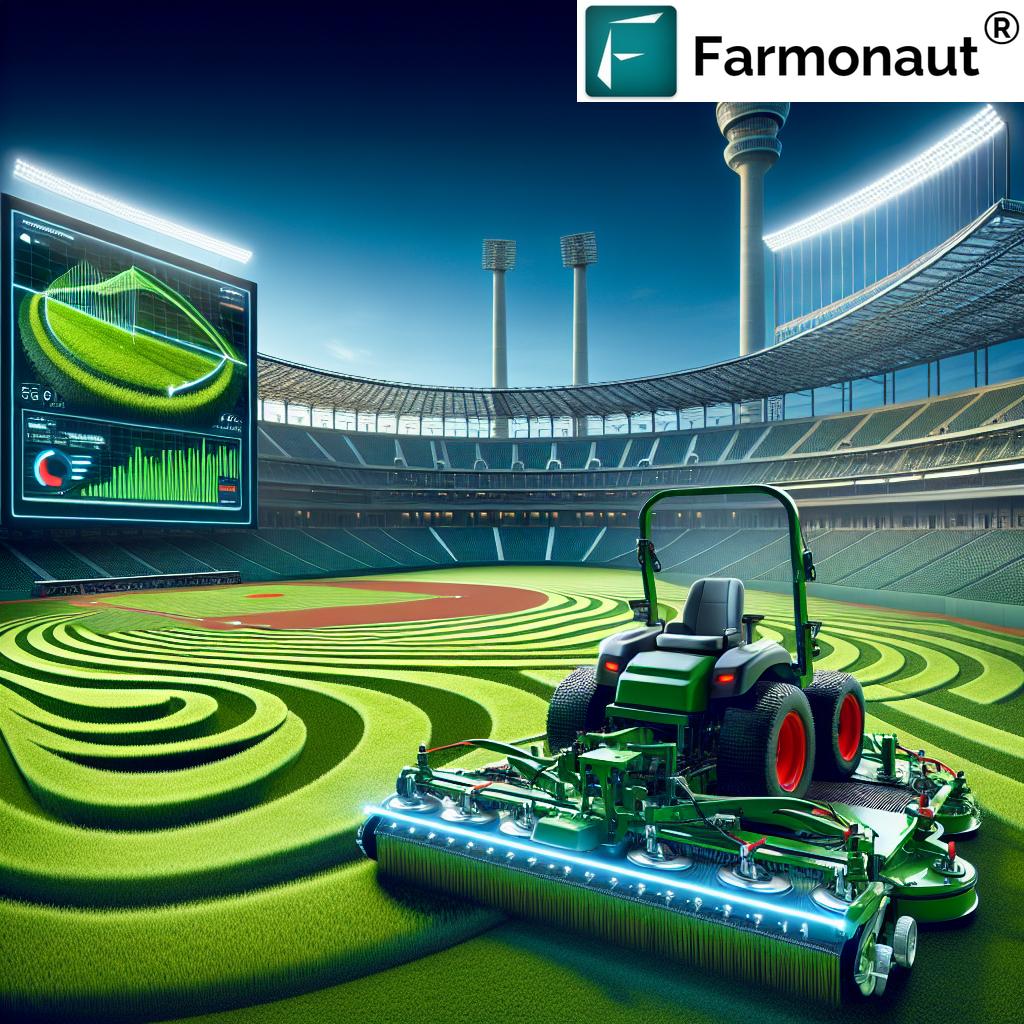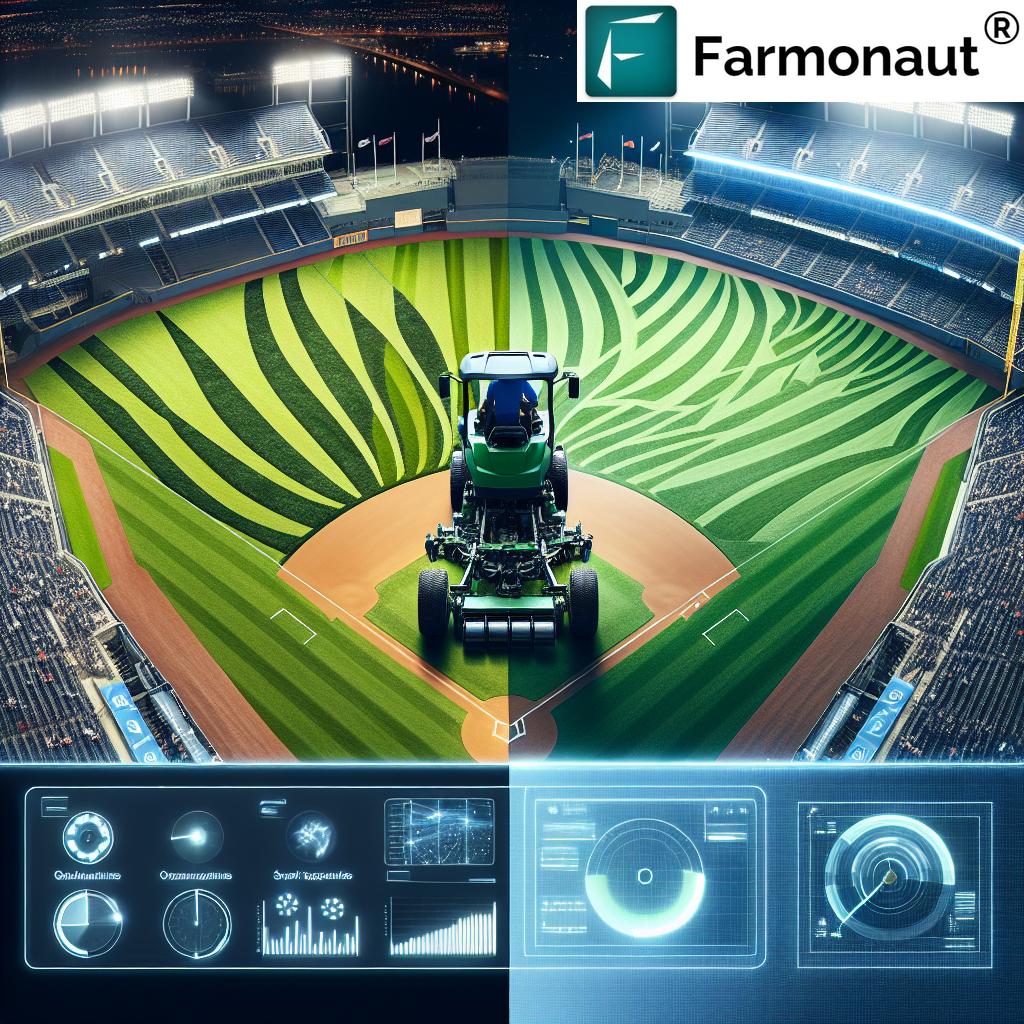Innovative Turf Management: GPS-Enabled Mowing Patterns Revolutionize Baseball Field Aesthetics in Madison, WI
“GPS-enabled mowers can create intricate patterns on baseball fields with precision accuracy of up to 1 inch.”
In the heart of America’s Dairyland, Madison, Wisconsin, a revolution in turf management is taking root on baseball fields across the city. As we delve into the fascinating world where precision farming technology meets sports field maintenance, we uncover how innovative crop production methods and environmental agronomy practices are transforming both the aesthetics and sustainability of America’s favorite pastime.
Our journey through this groundbreaking intersection of agronomy and athletics will explore how GPS-enabled agricultural equipment, advanced mowing patterns, and sustainable agriculture techniques are not only enhancing the visual appeal of baseball outfields but also addressing critical issues of soil conservation and resource management.
The Science Behind the Stripes: Understanding Turf Management Systems
At the core of this revolution in baseball field aesthetics lies a deep understanding of turfgrass science and agronomic practices. Traditional turf management has long been an art form, but with the advent of precision farming technology, it has evolved into a precise science.
- Turfgrass Selection: Choosing the right grass species for local climate conditions
- Soil Health: Maintaining optimal pH levels and nutrient balance
- Water Management: Implementing efficient irrigation systems
- Mowing Techniques: Utilizing advanced equipment for precise cutting
The integration of GPS technology into turf management systems has opened up new possibilities for creating complex and visually stunning mowing patterns. This precision allows groundskeepers to achieve a level of detail and consistency that was previously unattainable.

GPS-Enabled Agricultural Equipment: Precision on the Field
The introduction of GPS-enabled agricultural equipment to baseball field maintenance has been a game-changer. These high-tech mowers and rollers use satellite positioning to create intricate patterns with incredible accuracy.
- Sub-inch Precision: Mowers guided by GPS can maintain consistent lines within fractions of an inch
- Complex Designs: Ability to create elaborate geometric patterns and even artistic designs
- Repeatability: Patterns can be saved and reproduced with exact precision game after game
- Efficiency: Reduced overlap and missed spots, saving time and resources
This level of precision not only enhances the visual appeal of the field but also contributes to more uniform grass growth and improved playability.
Advanced Mowing Patterns: Where Art Meets Science
The creation of advanced mowing patterns is where the true artistry of turf management shines. Groundskeepers in Madison, WI, are pushing the boundaries of what’s possible, creating designs that captivate audiences and players alike.
- Light and Dark Contrasts: Achieved by bending grass blades in opposite directions
- Optical Illusions: Patterns that appear to change based on viewing angle
- Thematic Designs: Incorporating team logos or seasonal motifs
- Dynamic Patterns: Changing designs throughout the season to keep the field fresh
These patterns are not just for show; they can also serve practical purposes such as disguising wear patterns or directing water flow.
Environmental Agronomy Practices in Sports Field Maintenance
As we strive for stunning aesthetics, it’s crucial to consider the environmental impact of our turf management practices. Madison’s groundskeepers are at the forefront of implementing sustainable agriculture techniques in their work.
- Water Conservation: Using soil moisture sensors and smart irrigation systems
- Integrated Pest Management: Reducing reliance on chemical pesticides
- Organic Fertilizers: Implementing slow-release nutrients for healthier soil
- Native Plant Integration: Incorporating local species in landscaping around the field
These practices not only benefit the environment but also contribute to the long-term health and resilience of the turfgrass.
Innovative Crop Production Methods Applied to Baseball Fields
Many of the innovative crop production methods developed for agriculture are finding new applications in sports turf management. These techniques are helping to create more resilient and sustainable baseball fields.
- Precision Soil Sampling: Tailoring nutrient applications to specific areas of the field
- Cover Cropping: Using off-season plantings to improve soil health
- Biochar Application: Enhancing soil structure and water retention
- Drone Technology: Monitoring field health and identifying problem areas early
By adopting these agricultural innovations, baseball fields in Madison are becoming more sustainable and easier to maintain.
“Advanced turfgrass management techniques can reduce water usage in baseball fields by up to 30% annually.”
The Role of Agricultural Research and Development
The advancements we’re seeing in baseball field aesthetics and maintenance are a direct result of ongoing agricultural research and development. Institutions in Madison, such as the University of Wisconsin-Madison, are at the forefront of this work.
- Turfgrass Breeding Programs: Developing grass varieties better suited for sports fields
- Soil Science Advancements: Improving our understanding of soil biology and chemistry
- Climate Change Adaptation: Researching ways to maintain healthy turf in changing conditions
- Technology Integration: Exploring new applications for precision agriculture tools
This research is crucial for the continued evolution of turf management practices and the sustainability of sports fields.

Agronomic Soil Conservation in Sports Field Management
Soil conservation is a critical aspect of sustainable turf management. The techniques used in agricultural soil conservation are being adapted for use on baseball fields to prevent erosion and maintain soil health.
- Contour Mowing: Following the natural contours of the land to reduce runoff
- Aeration Practices: Reducing soil compaction to improve water infiltration
- Compost Top-dressing: Adding organic matter to enhance soil structure
- Grass Clipping Management: Recycling nutrients back into the soil
These practices not only contribute to the health of the field but also align with broader environmental conservation efforts.
The Future of Turf Management: Precision, Sustainability, and Aesthetics
As we look to the future of turf management in Madison and beyond, we see a convergence of precision technology, sustainable practices, and aesthetic innovation. The baseball fields of tomorrow will be marvels of agronomic science and artistic expression.
- AI-Driven Management: Using machine learning to optimize maintenance schedules
- Virtual Reality Design: Planning and visualizing field patterns before implementation
- Biometrics Integration: Tailoring field conditions to player performance data
- Carbon Sequestration: Exploring ways for sports fields to act as carbon sinks
These advancements promise to make baseball fields more beautiful, more sustainable, and more enjoyable for players and fans alike.
Comparative Analysis: Traditional vs. GPS-Enabled Turf Management
| Aspect | Traditional Method | GPS-Enabled Method |
|---|---|---|
| Mowing Precision | ±2 inches | ±0.5 inches |
| Pattern Complexity | Limited to simple stripes | Intricate geometric designs possible |
| Time Efficiency | Varies based on operator skill | Up to 30% faster with automated guidance |
| Environmental Impact | Higher resource use due to overlap | Reduced fuel and chemical usage |
| Aesthetic Appeal | Good, dependent on operator skill | Exceptional, consistent, and reproducible |
The Role of Technology in Modern Turf Management
In the realm of modern turf management, technology plays a pivotal role in enhancing efficiency, precision, and sustainability. Farmonaut, a pioneering agricultural technology company, offers advanced solutions that can be adapted for turf management in sports fields.
While Farmonaut’s primary focus is on broader agricultural applications, many of its technologies have potential uses in specialized areas like baseball field maintenance:
- Satellite-Based Monitoring: Real-time assessment of field health and vegetation indices
- AI Advisory Systems: Customized maintenance recommendations based on field conditions
- Resource Management Tools: Optimizing water and fertilizer use for sustainable turf care
These technologies, when applied to turf management, can significantly improve the precision and effectiveness of field maintenance practices.
Explore Farmonaut’s innovative solutions:
Integrating Precision Agriculture with Sports Field Management
The principles of precision agriculture, which Farmonaut specializes in, can be adapted to enhance sports field management:
- Variable Rate Application: Tailoring fertilizer and pesticide applications to specific areas of need
- Soil Moisture Monitoring: Using sensors to optimize irrigation and prevent overwatering
- Spectral Analysis: Identifying early signs of disease or stress in turfgrass
By leveraging these technologies, groundskeepers can make data-driven decisions to improve field quality and sustainability.
The Intersection of Agronomic Research and Sports Turf Management
The advancements in baseball field aesthetics and maintenance in Madison, WI, are a testament to the power of interdisciplinary collaboration. Agronomic research, originally focused on crop production, is finding new applications in sports turf management:
- Plant Genetics: Developing turfgrass varieties with enhanced resilience and visual appeal
- Soil Microbiology: Harnessing beneficial microorganisms for natural pest control
- Climate Adaptation: Creating management strategies for changing environmental conditions
This cross-pollination of ideas between agriculture and sports field management is driving innovation and sustainability in both sectors.
Sustainable Practices for Long-Term Field Health
Adopting sustainable practices is crucial for maintaining the long-term health and beauty of baseball fields. Madison’s groundskeepers are implementing various techniques to reduce environmental impact:
- Rainwater Harvesting: Collecting and reusing rainwater for irrigation
- Native Landscaping: Using local plant species in non-playing areas to support biodiversity
- Organic Fertilization: Transitioning to natural fertilizers to improve soil health
- Energy-Efficient Equipment: Utilizing electric mowers and maintenance vehicles
These practices not only benefit the environment but also contribute to the overall resilience and quality of the playing surface.
The Impact of Advanced Turf Management on Player Performance
The innovations in turf management aren’t just about aesthetics; they also have a significant impact on player performance and safety:
- Consistent Playing Surface: Improved ball roll and bounce for fair play
- Injury Prevention: Softer, more resilient turf to reduce the risk of player injuries
- Optimal Traction: Carefully managed grass density for ideal footing
- Weather Resilience: Fields that perform well in various weather conditions
By focusing on these aspects, groundskeepers are enhancing both the beauty and functionality of baseball fields.
The Future of Baseball Field Aesthetics
As we look to the future, the possibilities for baseball field aesthetics are boundless. Emerging technologies and continued research promise even more impressive and sustainable field designs:
- Augmented Reality: Enhancing fan experience with interactive field displays
- Bioengineered Turfgrass: Grass varieties with built-in patterns or color variations
- Smart Field Systems: Automated maintenance based on real-time field conditions
- Eco-Friendly Alternatives: Exploring sustainable materials for synthetic fields
These advancements will continue to push the boundaries of what’s possible in sports field design and management.
Conclusion: A New Era in Turf Management
The revolution in turf management we’re witnessing in Madison, WI, represents a new era in the intersection of agriculture, technology, and sports. By embracing GPS-enabled mowing patterns, sustainable agriculture techniques, and innovative crop production methods, groundskeepers are creating baseball fields that are not only visually stunning but also more sustainable and performant than ever before.
As we continue to push the boundaries of what’s possible in field aesthetics and maintenance, we’re not just enhancing the beauty of America’s pastime – we’re contributing to a more sustainable and technologically advanced future for all forms of land management.
The lessons learned and techniques developed on these baseball fields have far-reaching implications, potentially transforming approaches to agriculture, landscaping, and environmental conservation. It’s a testament to the power of innovation and the endless possibilities that arise when different fields of expertise come together to solve complex challenges.
FAQs
- How does GPS technology improve mowing patterns on baseball fields?
GPS technology allows for precise control of mowers, enabling the creation of intricate patterns with accuracy up to 1 inch. This results in more complex designs and consistent results. - What are the environmental benefits of advanced turf management techniques?
Advanced techniques can reduce water usage by up to 30%, minimize chemical use through precision application, and improve soil health, contributing to overall environmental sustainability. - How do these innovative practices affect player performance?
Improved turf management leads to more consistent playing surfaces, better traction, and reduced injury risks, all of which can enhance player performance and safety. - Can these techniques be applied to other types of sports fields?
Yes, many of these techniques can be adapted for use on soccer fields, golf courses, and other sports turf areas, with adjustments made for specific sport requirements. - What role does agricultural research play in baseball field management?
Agricultural research contributes to developing better turfgrass varieties, improving soil health techniques, and advancing precision management technologies that can be applied to sports fields.
















